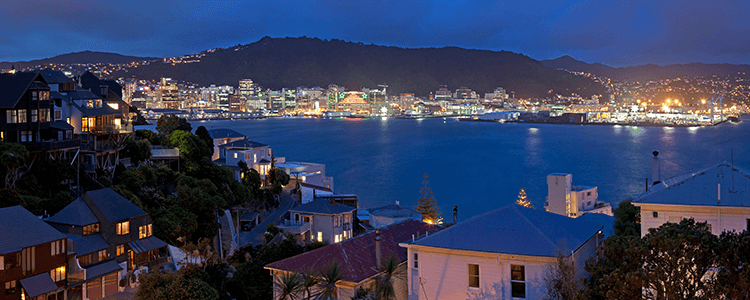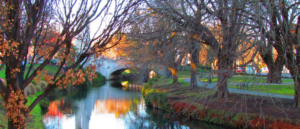Windy Wellington
Nestled between rolling hills and a picturesque harbour, Wellington or Te Whanganui-a-Tara in Maori, lies New Zealand’s capital. It is situated at the south-western tip of the North Island between Cook Strait and the Remutaka Range.
Wellington is ranked 12th on the list of most liveable cities in the world and first for the least polluted city. Lonely Planet describes it as the coolest little capital in the world. Another moniker for this city is “Windy Wellington” due to the frequent strong, gusty northerlies that Wellington experiences.
Although William Hobson named Auckland the capital of New Zealand in 1841 in 1865, the titled was bestowed on Wellington.
Wellington is at the south-western tip of the North Island on Cook Strait and separates the North and South Islands. The snowcapped Kaikoura Ranges are visible on a clear day and to the north one could see stretches of Kapiti Coast’s golden beaches. On the east the Remutaka Range divides Wellington from the broad plains of the Wairarapa, a notable wine region.
Wellington’s population is estimated at 430,000 with 99% located in the urban area. The rest of the population or 1% can be found in the rural mountainous area and the sparse farmlands. Census conducted in 2013 showed that 44% of Wellingtonians did not follow any religion. The largest religious sector were Christians at 39%. However, census polls taken seven years previously indicates that this percentage had dropped to 39% from the previous 50%. 27% of Wellington’s residents were born overseas with 8% having been born in the United Kingdom.
Buildings of Architectural significance
Some of Wellington’s architectural sights include the Old Government Building, one of the largest wooden buildings in the world and the executive wing of the Parliament Building referred to as the Beehive or skep. Wellington also houses several of the largest and oldest cultural institutions in the nation, such as the National Archives, the National Library, the Museum of New Zealand Te Papa Tongarewa, and numerous theatres. Old St Paul’s Cathedral was the Anglican pro-cathedral, and one of the oldest structures in Wellington. Old St Paul’s Cathedral and St Mary of the Angels have 19th-century Gothic Revival architectures adapted to colonial conditions and materials. Sacred Heart Cathedral is a Palladian Revival Basilica with a portico like a Roman or Greek temple. The Museum of Wellington City and Sea in the Bond Store is in the French Empire style, and the Wellington Harbour Board Wharf Office Building was built in the classical late-English style. Several restored theatre buildings include: the St James Theatre, the Opera House and the Embassy Theatre.
The Museum of New Zealand Te Papa Tongarewa a modern building lies on the waterfront, on Cable Street. It has been strengthened using base isolation, positioning the entire building on supports made from lead, steel and rubber to reduce the effects of an earthquake which Wellington is prone to.
Other notable buildings include Wellington’s Town Hall, Railway Station, Dominion Museum (now Massey University), Aon Centre, Regional Stadium, and Airport at Rongotai.
Wellington’s Museum in the Bond Store is built in the early 1890s a classic Victorian building in the French Second Empire style.
Wellington also has many iconic sculptures and structures, like the Bucket Fountain in Cuba Street and the Invisible City by Anton Parsons located on Lambton Quay. The Zephyrometer is a public sculpture created by Phil Price in Evans Bay. The work is a kinetic sculpture consisting of a concrete cylinder holding a 26-metre tall needle which sways to show wind direction and speed. The structure was installed in 2003. This 26-metre orange spike built for movement has been described as “tall, soaring and elegantly simple”, which “reflects the swaying of the yacht masts in the Evans Bay Marina behind it” and “moves like the needle on the dial of a nautical instrument, measuring the speed of the sea, wind or vessel.”
Besides the extensive architectural styles already mentioned, add to the list the classic Painted Ladies in Mount Victoria, Newtown and Oriental Bay, the Wooden Art Deco houses, the classic masonry buildings in Cuba Street, the state houses in the Hutt and Wellington’s southern suburbs, railway houses in Ngaio and other railway-side suburbs, large modern buildings in the city centre and the distinctive skyscraper called the Majestic Centre.
Wellington’s history
Wellington and the surrounding areas have been occupied by various Māori groups from the 12th century. The legendary explorer Kupe, a chief from Hawaiki (a Polynesian explorer, of unconfirmed geographical location, not Hawaii), was said to have stayed in the harbour from circa 925. Another Māori explorer, Whatonga, named the harbour Te Whanganui-a-Tara after his son Tara. Prior to the 1820s, most of the inhabitants of the Wellington region were Whatonga’s descendants.
European (Pākehā) settlement began in 1839, when Colonel William Wakefield arrived to purchase land for the New Zealand Company to sell to prospective British settlers. An advance party of the New Zealand Company arrived on the ship Tory on 20 September 1839, followed in January 1840 by the first settler ship, the Aurora with 150 settlers arriving at Petone. They founded the settlement that became Wellington. Prior to this, the Māori inhabitants were in contact with European (Pākehā) whalers and traders.
Although William Hobson named Auckland the capital of New Zealand in 1841, the title was later bestowed on Wellington in 1865.
Wellington is one of New Zealand’s chief seaports for both domestic and international shipping. Wellington International Airport is the country’s third busiest airport. Wellington’s transport network includes train and bus lines which extend as far as the Kapiti Coast and the Wairarapa, with ferries connecting the city to the South Island.
The Wellington region has large expanses of regional parks and forests. In the east is the Miramar Peninsula, connected to the rest of the city by a low-lying isthmus at Rongotai, where the Wellington International Airport is located. The Hutt Valley is the industrial hub with food-processing plants, engineering industries, vehicle assemblies and oil refineries.
This city’s rich history, wide transport networks and architectural charm make it a great destination to relocate to. Grace Removals’ expertise will help you make this a calm, stress-free move.
Climate
Wellington rarely experiences temperatures above 25 degrees Celsius or below 4 degrees Celsius. The hottest recorded temperature was 32 degrees Celsius and -2 degrees was the coldest recorded temperature. It is usually windy all year round with strong winds making the temperature feel much colder. The average annual rainfall is 1,250 mm with June and July being the wettest months. Frost is common in Hutt Valley between May and September.
Wellington has been subjected to a series of earthquakes. The area experiences high seismic activities even by New Zealand standards, with a major fault, the Wellington Fault, running through the centre of the city. Several hundred minor faults lines have been identified within the urban area. For many years after the 1855’s earthquake, most buildings were made completely from wood. The 1996-restored Government Building near Parliament is the largest wooden building in the Southern Hemisphere. Although masonry and structural steel have since been used in building construction, especially for office buildings, timber frames remain to be main structural material for almost all residential constructions.
Transportation
If you are planning to move to Wellington, the chances of you needing a car is pretty slim with Wellington’s extensive public transport network which includes bus services, five passenger rail lines, a cable car, and the harbour ferry services so easily accessible.
Wellington is serviced by the State Highway 1 in the west and the State Highway 2 in the east. These meet at the Ngauranga Interchange north of the city centre where State Highway 1 runs through the city to the airport. Road access into the capital is constrained by the mountainous terrain – between Wellington and the Kapiti Coast. State Highway 1 travels along the Centennial Highway on a narrow section of road. Between Wellington and Wairarapa State Highway 2 crosses the Rimutaka Ranges also via a narrow winding road. Wellington has two motorways, both part of State Highway 1. They are the Johnsonville–Porirua Motorway and the Wellington Urban Motorway, which in combination with a small non-motorway section in the Ngauranga Gorge connects Porirua to Wellington city.
Several different operators under Metlink’s management provide bus transport for the city. Buses serve almost every part of Wellington city, with most of them travel along the “Golden Mile” from Wellington railway station to Courtenay Place.
Wellington region’s passenger rail network is made up of five lines travelling to Johnsonville, Waikanae, Lower Hutt, Upper Hutt and Masterton. These five services combined carry over 12 million passengers each year.
Johnsonville line from Johnsonville through the hillside suburbs north of central Wellington
Kapiti line to Waikanae on the Kapiti Coast via Porirua and Paraparaumu
Melling line to Lower Hutt via Petone (Lower Hutt-Wellington)
Hutt Valley line (Upper Hutt-Wellington)
Wairarapa line (Masterton-Wellington). A diesel-hauled carriage service, the Wairarapa Connection, connects to Masterton in Wairarapa via the 8.8-kilometre-long Rimutaka Tunnel several times a day.
Wellington lies at the southern end of the North Island Main Trunk railway (NIMT) and the Wairarapa Line, they converge on Wellington railway station. The two long-distance services also depart from Wellington. These are: Capital Connection carrying commuters from Palmerston North, and the Northern Explorer to Auckland.
The Wellington Cable Car runs between Lambton Quay, the main shopping street in the city centre, and the top of the Botanic Garden in Kelburn, providing spectacular city and harbour views. The cable car climbs 120 m over a length of 612 m. The one-way trip takes approximately five minutes.
Wellington serves as the North Island Port for Cook Strait ferries. Interislander Cook Strait ferries, a state-owned ferry service sails between Wellington and Picton several times a day and privately owned Bluebridge Cook Strait Ferries sail between Wellington city and Picton 50 times a week. Local ferries connect Wellington city centre to Eastbourne and Seatoun. West Ferries depart from Queens Wharf in Wellington’s CBD.
Wellington International Airport is a mere 6 kilometres south-east of the city centre. It is serviced by flights from across New Zealand, Australia, Singapore and Fiji. Wellington airport’s runway is short (2,081 metres) making it inadequate for larger aircrafts to land or take off from here. Flights to other destinations require a transfer to another airport hampering the region’s economic performance.
If you are looking for a destination that provides education, entertainment, transport and everything else in between, Wellington might be the right one for you. Call Grace Removals on 1300 723 844 to avail yourself of the best removalists in Australasia. Grace has over 100 years’ experience relocating and moving people across the world. Grace will make your move as seamless as possible. Our services are exceptional and our prices reasonable.


